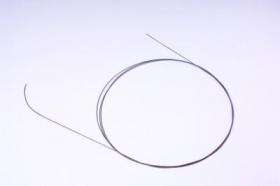Inserting Catheters Without X-rays

X-rays penetrate the patient's body, helping the doctor guide the catheter through the artery. In future, it will be possible to monitor the position of the catheter without exposing the patient to X-ray radiation, and without the need for a contrast medium.
Have the patient's coronary vessels, heart valves or myocardial muscle changed abnormally? Doctors can verify this and administer the necessary therapy with the help of a catheter, which is inserted into the body through a small incision in the groin area and pushed to the heart through the vascular system.
A metal guide wire inside the catheter serves as a navigational aid. It is pulled and turned by the physician to steer and guide the catheter. At the same time the catheter's position in the vascular system has to be monitored. This task is performed by X-rays, which penetrate the patient and show exactly where the catheter is. The problem with this computer tomography method is that it exposes the patient to quite a high dose of radiation. In addition, a contrast medium has to be injected into the patient's body in order to make the vascular system and the soft tissue visible on the X-ray images.
Researchers at the Fraunhofer Institute for Production Technology IPT in Aachen have now found a way of avoiding both the radiation and the contrast medium. In collaboration with colleagues at Philips and University Hospital Aachen, they have developed a guide wire made of glass-fiber-reinforced plastic. "Because the guide wire is made of plastic the imaging can be performed by magnetic resonance tomography instead of computer tomography," says IPT scientist Adrian Schütte. "This is not possible with metal guide wires as the metal wire acts as an antenna and heats up too much - this would damage the vessels, and could cause proteins to clot." Magnetic resonance tomography has many advantages for doctors and patients. It does not produce ionizing radiation like computer tomography, and soft tissue is clearly visible, so there is no need for a contrast medium.
For the manufacture of the two-meter guide wires the researchers use the pultrusion method, which is the standard procedure for making continuous profiles from glass-fiber-reinforced plastic. "Diameters of half a millimeter or less are required for the guide wires - that's the absolute minimum," explains Schütte. The new guide wires will be presented at the JEC trade fair in Paris from March 24 to 26 and will be used in hospitals for the first time in the next few months.
Source: Fraunhofer-Gesellschaft

















